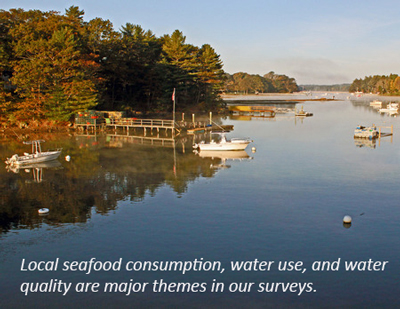
Scientists conduct research that evaluates the health of our region’s watersheds. Local officials then make recommendations to the public based on the findings of scientists. Based on this knowledge, it's important to know what the average citizen does with recommendations such as beach advisories, how the public interprets various sources of scientific information, and how these attitudes and behaviors could contribute to potential health outbreaks associated with bacteria in our region’s waterways. Through telephone surveys of New Hampshire residents, we can understand how scientists' and policy-makers' water quality messages are received and interpreted by the public. These surveys include topics such as the consumption of seafood and shellfish, the use of beaches, and opinions about science and scientists. In addition, we complement our understanding by talking in-depth with lifeguards, local business owners, and public officials in the coastal region of Maine.
This project relies on two forms of data collection. First, it utilizes survey data of New Hampshire residents in order to assess the public’s knowledge of, and attitudes about, seafood issues, water use and water quality, and science. Second, it consists of forty in-depth interviews with lifeguards, retail businesses, accommodation providers, and restaurant business managers in York, Maine.
Beginning in the spring of 2014, we asked a random sample of New Hampshire residents about issues related to seafood consumption and their trust in scientists by adding several questions to the Granite State Poll (GSP), a regularly conducted telephone survey by the University of New Hampshire Survey Center. We repeated the study in the spring of 2015 by also asking about how people evaluate different information sources when trying to determine the safety of seafood, and in the fall of 2015 by asking about water quality, beach advisories, and beach activities. In the spring of 2016, we repeated many of these earlier questions and added new questions about residents’ decision-making strategies in assessing the health of local seafood, views on the importance of local water pollution, and hypothetical scenarios related to economic development and water preservation. The result is a pooled data set of over 2,100 respondents.
As these survey data were collected, we complemented this analysis with a qualitative research component. Beginning in the summer of 2014, we visited a number of “key players” in the aquaculture and seafood production field in coastal Maine. During these visits, we asked about the relationship between the role of scientific research in informing their work and how the public perceives their work. In 2015, we interviewed managers of restaurants, retail outlets, and accommodation facilities to understand the impact that water quality research has on their businesses. Lifeguards were also interviewed in order to examine the messages they received and conveyed to beachgoers about beach advisories when water quality is poor.